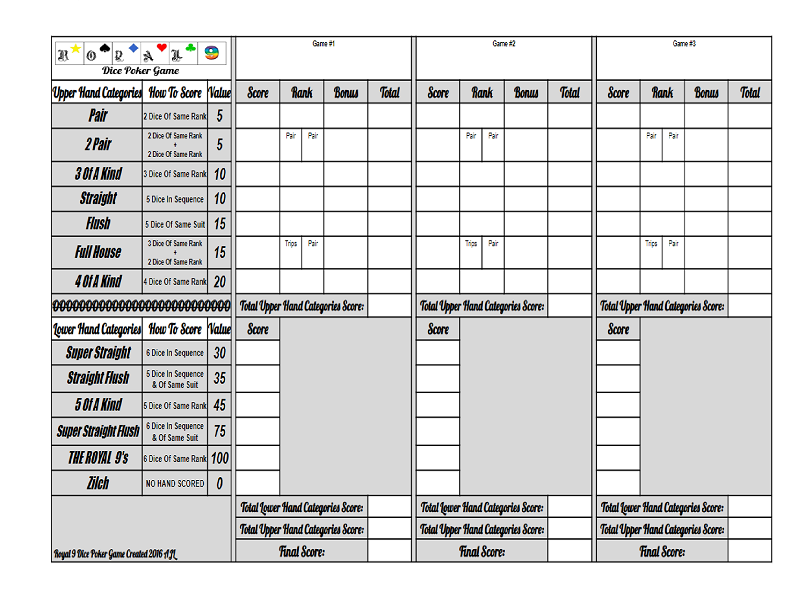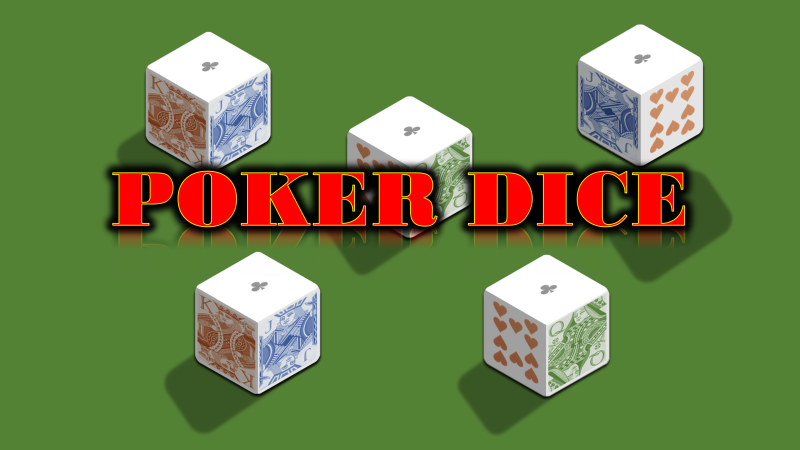Poker With Dice Rules
Dice Poker $69.95 plus tax Objective: Try and complete two lines of five in a row & block your opponent. Make all your moves by rolling dice. Size 20 1/2' by 20 1/2' - Made of Canadian Hard Maple & Baltic Birch - All lines & numbers are right into the wood (which will never wear over time). Liar's Dice Game Rules Adapted from post by Dice Game Depot There are many names for this popular dice game, such as Doubting Dice, Dudo, Perudo, Mexacali, Call My Bluff, 'pirate's dice,' 'deception dice,' and so on. But regardless of the name, Liar's Dice requires two. Other games you will be able to play on Poker Dice Rules Betting the site include Baccarat, Monopoly Live, Punto Banco, Dream Catcher, Side Bet City, Super Sic Bo, and Football Studio. The live dealer games are not available for free play, so you should login and make a deposit before launching them. Freespin Available! Now you have Poker With Dice Rules €200 to play with. If you bet €200 on colour in Roulette you basically have 49% chance to win €400 when only risking €100 of your own money. If you win, then you head to the slots and bet pretty decent stakes in order to get a big win Poker With Dice Rules. Poker With Dice Rules Free spins will be available to play Poker With Dice Rules in Starburst. Maximum bet while wagering: €5. Bonus is valid for 14 days (free spins valid for seven days). Terms and Poker With Dice Rules conditions apply to cash and free spin offers. Read more about N1 Casino: €300 Bonus + 120 Free Spins Poker With.
- Poker With Dice Rules
- Polish Poker With Dice Rules
- Witcher Dice Poker Rules
- Poker Dice Game Rules
- Poker Dice Rules Betting
Liar's dice is a class of dice games for two or more players requiring the ability to deceive and to detect an opponent's deception.
In 'single hand' liar's dice games, each player has a set of dice, all players roll once, and the bids relate to the dice each player can see (their hand) plus all the concealed dice (the other players' hands). In 'common hand' games, there is one set of dice which is passed from player to player. The bids relate to the dice as they are in front of the bidder after selected dice have been re-rolled.
Single hand[edit]
Poker With Dice Rules

Five dice are used per player with dice cups used for concealment.
Each round, each player rolls a 'hand' of dice under their cup and looks at their hand while keeping it concealed from the other players. The first player begins bidding, announcing any face value and the minimum number of dice that the player believes are showing that value, under all of the cups in the game. Ones are often wild, always counting as the face of the current bid.
Turns rotate among the players in a clockwise order. Each player has two choices during their turn: to make a higher bid, or challenge the previous bid—typically with a call of 'liar'. Raising the bid means either increasing the quantity, or the face value, or both, according to the specific bidding rules used. There are many variants of allowed and disallowed bids; common bidding variants, given a previous bid of an arbitrary quantity and face value, include:
- the player may bid a higher quantity of any particular face, or the same quantity of a higher face (allowing a player to 're-assert' a face value they believe prevalent if another player increased the face value on their bid);
- the player may bid a higher quantity of the same face, or any particular quantity of a higher face (allowing a player to 'reset' the quantity);
- the player may bid a higher quantity of the same face or the same quantity of a higher face (the most restrictive; a reduction in either face value or quantity is usually not allowed).
If the current player challenges the previous bid, all dice are revealed. If the bid is valid (at least as many of the face value and any wild aces are showing as were bid), the bidder wins. Otherwise, the challenger wins. The player who loses a round loses one of their dice. The last player to still retain a die (or dice) is the winner. The loser of the last round starts the bidding on the next round. If the loser of the last round was eliminated, the next player starts the new round.
Dice odds[edit]
For a given number of unknown dice n, the probability that exactly a certain quantity q of any face value are showing, P(q), is
Where C(n,q) is the number of unique subsets of q dice out of the set of n unknown dice. In other words, the number of dice with any particular face value follows the binomial distribution.
For the same n, the probability P'(q) that at least q dice are showing a given face is the sum of P(x) for all x such that q ≤ x ≤ n, or


These equations can be used to calculate and chart the probability of exactly q and at least q for any or multiple n. For most purposes, it is sufficient to know the following facts of dice probability:
- The expected quantity of any face value among a number of unknown dice is one-sixth the total unknown dice.
- A bid of the expected quantity (or twice the expected value when playing with wilds), rounded down, has a greater than 50% chance of being correct and the highest chance of being exactly correct.[1]
Common hand[edit]
The 'Common hand' version is for two players. The first caller is determined at random. Both players then roll their dice at the same time, and examine their hands. Hands are called in style similar to poker, and the game may be played with poker dice:
- Five of a kind: e.g., 44444
- Four of a kind: e.g., 22225
- High straight: 23456
- Full house: e.g., 66111
- Three of a kind: e.g., 44432
- Low straight: 12345
- Two pair: e.g., 22551
- Pair: e.g., 66532
- Runt: e.g., 13456
Polish Poker With Dice Rules
One player calls their hand. The other player may either call a higher-ranking hand, call the bluff, or re-roll some or all of their dice.[clarification needed] When a bluff is called, the accused bluffer reveals their dice and the winner is determined.[2]
Commercial versions[edit]
- 1993 Call My Bluff, by F.X. Schmid and designer Richard Borg, won the 1993 Spiel des Jahres and Deutscher Spiele Preis awards.[3]
See also[edit]
References[edit]
- ^Ferguson, Christopher P; Ferguson, Thomas S. 'Models for the Game of Liar's Dice'(PDF). University of California at Los Angeles. Retrieved 16 January 2013.
- ^Hoyle's Rules of Games, Third Revised and Updated Edition. Albert H. Morehead and Georffrey Mott-Smith - Revised and Updated by Philip D. Morehead
- ^1993 Spiel des Jahres
External links[edit]

- Liar's Dice at BoardGameGeek
Witcher Dice Poker Rules
Dice Poker is a simple game with a quick drift to events. The game is inspired by the well-known card version of Poker. Dice Poker is played with five dice, which have different figures. The goal of the game is to roll the highest combination possible. Compared to the card version of Poker there is no element of bluffing.
The Rules of Dice Poker
The number of players of the Dice Poker is not limited. Each player wagers the same amount of money, the highest poker combination/hand takes it all. The first player rolls five dice. If the player likes the hand he or she may decide to keep up with just one roll. Then the other players have also only one attempt.
It may happen in the situation when the first player thinks it is going to be difficult for other players to overcome his or her dice Poker combination. Generally the number of rolls is set according to the first player.
The first player can keep a specific hand if he or she is satisfied – for example three kings, then he or she rolls the remaining two dice. After the player finishes the round he or she hands over the dice to the next player. The variation with two rounds is the most usual. However the players can agree upon the third roll. Again the highest hand wins.

If two or more players have an equal combination, then the winner is determined by the next roll with five dice.
Poker Dice Game Rules
Dice Poker Combinations
Hand rankings come from the card version of Poker and they are as follow (from the strongest to the weakest hand):
Poker Dice Rules Betting
- Five of a Kind
- Poker (Four of a Kind)
- Full House 3+2
- Straight
- Three of a Kind
- Two Pairs
- One Pair